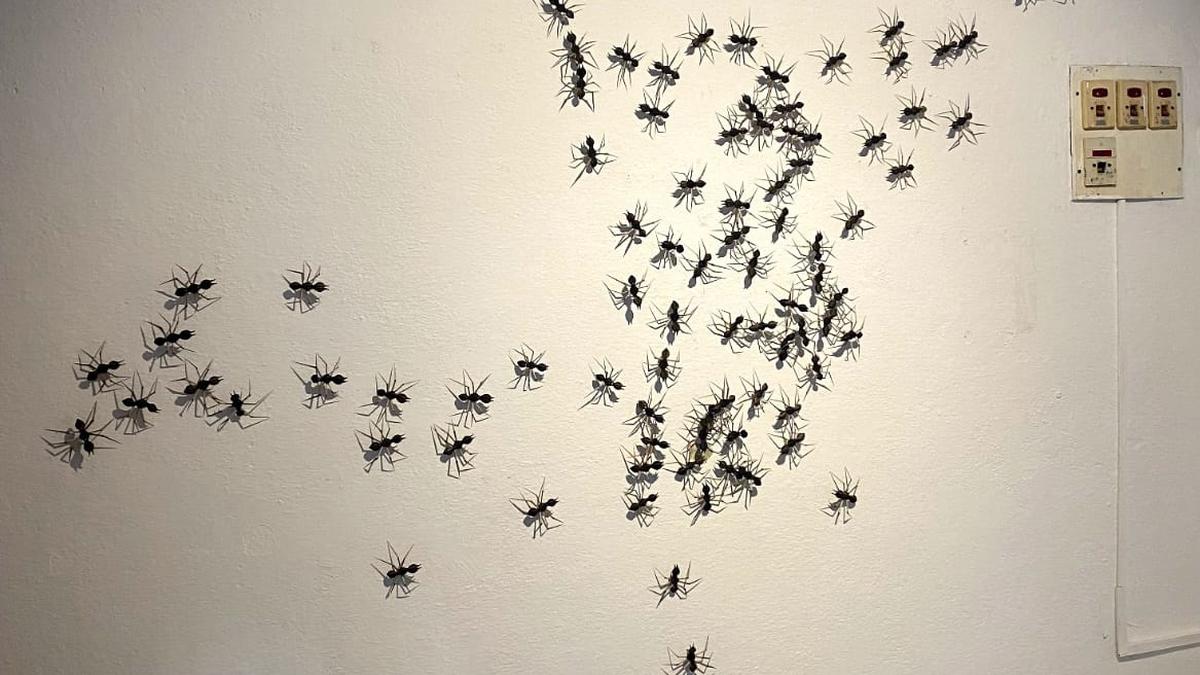
A confluence of art and nature
The Hindu
This installation is one of the two being exhibited at Kanike Studios, Cooke Town, till January 31, as part of the artist’s solo show titled Past Summers. The other, a more abstract assemblage hanging on the wall of the adjoining room, is also composed of natural materials; in this case, it is eucalyptus bark sutured together with nylon thread.
A cat ambles across the gallery, leaving paw prints on the sheet of sand surrounding an enormous effigy of an anthill from which scores of sculpted ants emanate, marching across the floors and walls in a ceaseless spiral. Look closer, and you will notice that each and every ant is composed solely of organic materials: bat head root seeds forming a surprisingly lifelike carapace affixed to jointed legs hewn from Samra tree spines “I work with anything natural,” says Krishnamurthy P.S., the artist behind this sculptural assemblage titled Death Circle, which represents the strange, natural phenomenon of an ant mill, the mass suicide of army ants when they lose a pheromone track and end up endlessly circling round and round, till they eventually drop dead of exhaustion.
“I have worked on this project for a month, documenting ants and their behaviour on my phone in the form of videos,” he says, adding that this constant observation of both ants and seeds helped him envision the form of the final object.
This installation is one of the two being exhibited at Kanike Studios, Cooke Town, till January 31, as part of the artist’s solo show titled Past Summers. The other, a more abstract assemblage hanging on the wall of the adjoining room, is also composed of natural materials; in this case, it is eucalyptus bark sutured together with nylon thread.
Krishnamurthy’s fascination for natural materials stems from a childhood spent in the hamlet of Panchavalli, located just outside the Nagarhole Tiger Reserve. “My family cleared the forest and created a home far from the (main) village,” recalls the 27-year-old. Since he was so far out, he didn’t have too many friends and would instead spend hours meandering through the forest, often stopping to pick up interesting objects that he discovered there. “The forest became my escape,” says Krishnamurthy, who moved to Kanakapura after his 10th grade to pursue an ITI electrician course, an experience he did not enjoy.
He had always enjoyed drawing, and so—in 2015—enrolled for a BVA at the Chamrajendra Government College of Visual Arts (CAVA) in Mysore. It was here that he was exposed to sculpture and the possibilities it offered. “I learnt how to envision things in 3D,” he says. However, he also knew that he did not want to use conventional materials such as clay, marble, stone or fibre in his art practice.
Instead, he turned back to the found natural objects he had always loved and collected since childhood. “I knew the texture and form of these objects...how keeping something like a leaf as an element, a larger piece could come together as a unit,” he says, adding that while he is aware of the impermanence of these objects, he truly enjoys the process of creating art with them. “This is what I want to do,” he says.
Past Summers, a solo show by Krishnamurthy P.S., is on at Kanike Studios, Cooke Town till January 31





















 Run 3 Space | Play Space Running Game
Run 3 Space | Play Space Running Game Traffic Jam 3D | Online Racing Game
Traffic Jam 3D | Online Racing Game Duck Hunt | Play Old Classic Game
Duck Hunt | Play Old Classic Game











